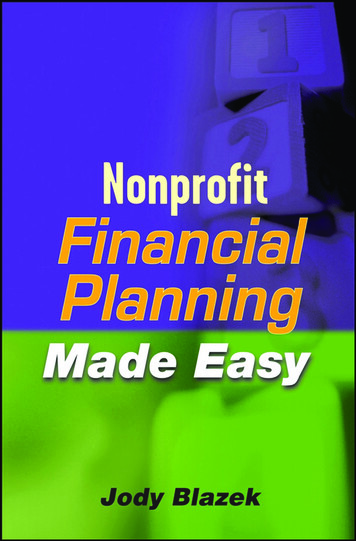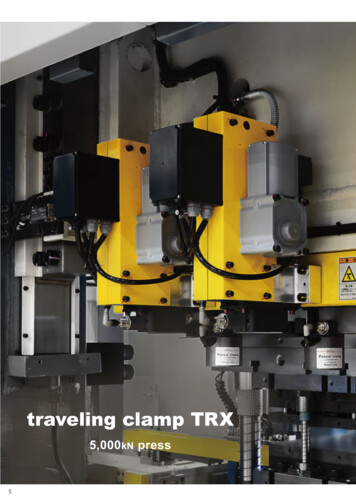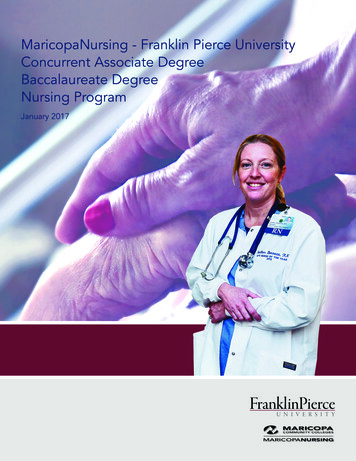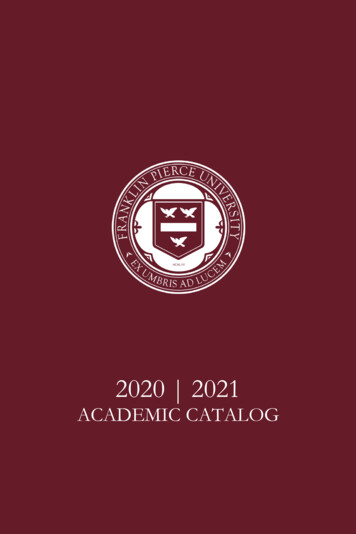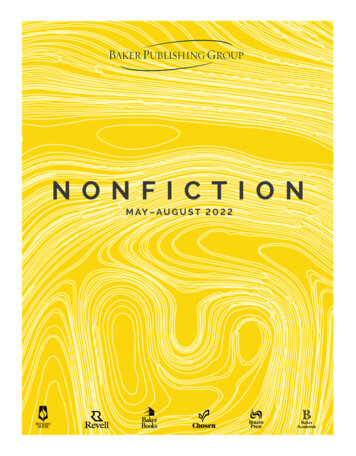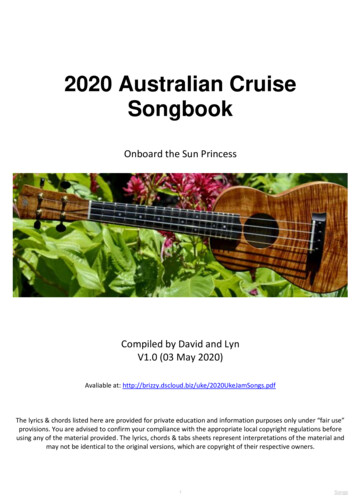
Transcription
SEPTEMBER 19–FEBRUARY 15TRAVELING EXHIBITK-12 EDUCATOR’S GUIDE
With one visit to Vatican Splendors, your students willexperience 2,000 years of history as they see over two hundredworks of art and historically significant objects including abrick from Saint Paul’s tomb, gold statues of Saints Peter, Paul,John, and Andrew, and Michelangelo’s calipers. Together, theartifacts form a great mosaic of the history of the Church andits impact on art, history, and culture.The Vatican has served as a repository for historical objects—such as reliquaries, maps, documents, vestments, and liturgicalitems, as well as cultural objects from around the world—allpresented in this exhibition, which help connect students withimportant moments in history. From the sights and sounds ofthe grand Basilica to a touchable cast of Saint John Paul II’shand, the exhibition is a multi-sensory experience that leadsstudents on a journey through the ages of artistic expressionand religious iconography.Vatican Splendors includes many artifacts which have neverbefore left Vatican City. The collection features renaissance artalong with work from the baroque period. The eleven gallerieswalk you through the history of Christianity focusing on theCatholic Church and the amazing religious art that came out ofRome. An impressive focus in the exhibition is on the Basilicato which Michelangelo and Bernini contributed artistically.DURING YOUR VISIT, STUDENTS WILL: Trace the history of the Catholic Church asit grew around the world. See distinct artifacts and artworksassociated with the church.AFTER YOUR VISIT, STUDENTS WILL: Think about how religion influences society. Understand that religion plays a rolein history.
QUICK TIPS The exhibit is located on the upper level of the Nicholas and Athena Karabots Pavilion. Enter the exhibit via the mainBartol Atrium. Your students will walk up a ramp to the entrance of the exhibit. On average, most groups will spend about 60 minutes in the exhibit, if carefully examining all of the displays.Restrooms are located in the Bartol Atrium. There are no restrooms inside the exhibit. An optional audio tour is available for 5.00 per person. If you would like to add this option, please contact ourGroup Sales team at 215.448.1200 (Option 3). No food or beverages are allowed in any of the exhibit galleries. Non-flash photography is permitted in the exhibit. Running through the exhibit is not allowed. Designate a meeting location within the exhibit when you arrive in casesomeone gets separated. Please do not congregate at the entrance/exit, however, so as to enable other guests toenter and exit easily.HOW TO PREPAREStudents should know that the artifacts on display are priceless works never before seen in Philadelphia. Theexhibit is not to be touched.Students should also know that many people consider the objects on display to be sacred and worthy ofadoration. They should behave accordingly, showing respect to others who may be in the exhibit.Chaperones and students should know that the museum encourages conversation around the displays andchildren should ask questions and discuss what they see. Museum etiquette suggests that the conversation bekept to an appropriate indoor volume level.Note that there is a gift shop near the exhibit which features items related to the exhibition at many pricelevels—from small souvenirs to collectible items. You do not have to pass through it, but it will likely attractyour students’ attention. Be prepared to direct your students accordingly to allow them time to shop or toproceed directly past to your next destination.
ABOUT THE EXHIBITThe Vatican Splendors exhibit features eleven smaller galleries. Asyou progress through the galleries, you will be exploring the 2,000year history of the Catholic Church.1. FOUNDATIONS OF THE CHURCHOur journey begins with Emperor Constantine’s declaration in312 AD that Christianity would be legal and his decision to buildBasilicas directly over the tombs of Saint Peter and Saint Paul. As aresult of these changes, Roman Christians no longer had to practicetheir faith in secret, and Christian art began to flourish.2. RISE OF CHRISTIAN ROMEThis gallery explores the Middle Ages and Byzantium period whenRome grew as a Christian city fostered by the papacy.3. RENAISSANCEVisitors learn how Christian art drew upon the art of Ancient Rome for inspiration, and the style created thatcombined Christian and non-Christian images. During this period, the Ancient Basilica was in extreme disrepair;however, the Filarete Doors—the ornate entry to the Ancient Basilica—were saved and used in the newer Basilica.4. MICHELANGELO & THE SISTINE CHAPELThis section explores the fiery relationship between Pope Julius II and Michelangelo during the painting of theSistine Chapel.5. THE NEW BASILICAIn 1506, Pope Julius authorized the construction of a new SaintPeter’s Basilica. Michelangelo was one of many architects whoworked on the new building. The famed artist Bernini alsocontributed much to the new basilica, as well as to the city ofRome as architect, painter, and sculptor.6. ART IN THE SERVICE OF THE FAITHDuring the period in which the Renaissance was at its height,the Protestant Reformation was born, and the CatholicReformation followed. The Council of Trent met from 1545 to1563 and established guidelines that art should be created inthe service of faith to deliver the message of Christianity inways accessible to ordinary people. This gallery presents thisstory with objects developed during this period of change.
7. ART OF THE LITURGYAs ritual instruments essential to the adorationof God, liturgical objects (implements used in thecelebration of the Mass) are often rich and splendid.Artists have seized the opportunity to create objectsthat are as beautiful and expressive as they aredurable and practical.8. DIALOGUE WITH THE WORLDFor centuries, the Church has engaged the worldthrough missionary outreach, teaching activities,and religious dialogue with both Christians and nonChristians. The Catholic Church’s interaction with theworld’s diverse societies and religions are reflectedin devotional art, most commonly provided as giftsto the Vatican, over many years.9. PAPAL PORTRAITUREPopes are traced back to the apostles of Jesus,particularly Peter, who is recognized as the first pope.Over the 2000 years of the papacy, a very largecollection of papal portraits has been collectedand conserved. Early pontiffs were portrayedin mosaics, in frescos, and on sarcophagi. Thetradition of portraiture was begun by John VII(705—707 AD), who commissioned images ofhimself for churches.10. ART IN THE MODERN PAPACYFrom its humble beginnings, the Vatican collections now span 4,500 years with objects dating back to ancientEgypt and Assyria, through the European Renaissance and Baroque eras, and forward to the present day. Forhundreds of years, the Church has collected, sponsored, and conserved buildings, frescos, paintings, sculptures,liturgical instruments, and other works.11. THE ROAD TO SAINTHOODThis gallery showcases artifacts associatedwith Pope Saint John Paul II, one of the mostbeloved popes.
TRY THIS!WHERE IN THE WORLD?Prepare for your visit to Vatican Splendors by orienting your students to the geography of Italy and the location ofVatican City. Use Google Maps to look at the region.1. Go to maps.google.com.2. Enter “Vatican City” in the search box.3. Use the map’s view controllers to switch back and forth between satellite and map views, comparingfeatures of each.4. While in satellite view, zoom in until the street view option is available. “Walk” around the Piazza SanPietro. Notice the architecture.5. Zoom out until the entire city of Rome and then the country of Italy is visible. Note how tiny VaticanCity is in comparison.ABOUT VATICAN CITYKnown officially as the Vatican City State (or Stato della Citta del Vaticano), the Vatican is a country within acountry with the Pope as its head of state. It is the world’s smallest principality, just 108 acres nestled withinthe city of Rome in Italy. Vatican City has its own diplomatic corps and security force, the Swiss Guard. Thesmall state even operates its own radio station, has one newspaper and a post office with its own stamps.Despite its small size, Vatican City State has profoundly shaped world history for centuries.
TRY THIS!THE SISTINE CHAPELIn the exhibit, students will see reproductions of the Sistine Chapel’s ceiling, one of the greatest treasures inVatican City. Construction began in 1475 during the reign of Pope Sixtus IV, for whom the chapel was named. Thearchitecture is simple in comparison to Saint Peter’s Basilica. The chapel is rectangular in shape, constructed to theexact dimensions of the original Temple of Solomon as given in the Bible. It is topped with a rounded half-barrel roof.A number of talented contemporary artists of the period were commissioned to decorate the interior of the chapelwith frescos. In 1508, Pope Julius II (nicknamed Julius the Terrible) commissioned Michelangelo to repaint the ceilingof the Sistine Chapel. Their fiery relationship sparked one of the supreme masterpieces of all art.Michelangelo never considered himself to be a painter. A talented sculptor, an ingenious architect and a tolerablepoet, he would say, but never a good painter. So when Pope Julius II insisted that Michelangelo paint the ceiling ofthe Sistine Chapel, he resisted. But the Pope would not budge—he was to undertake this massive project.Creating frescos is a difficult and physically exhausting process. With his characteristic energy, Michelangelo threwhimself into the project. For four years, he lay on his back on scaffolding fifty feet in the air, creating a series ofbeautiful images that retell the key stories of the Bible. He struggled to paint this nearly ten thousand square footceiling which was irregularly rounded and sometimes even leaking. But out of this great challenge emerged one ofthe world’s greatest pieces of artwork. Contrary to his own opinion of himself, Michelangelo was as gifted a painteras he was a sculptor.You can simulate Michelangelo’s experience in your classroom.Have your students lie on the floor under their desks and tape paper to the bottom of the desks. Try paintinga heavenly scene. If painting is too ambitious, try drawing with crayons.
VATICAN SPLENDORSSUGGESTED RESOURCES FOR K-12 CLASSROOMS AND LIBRARIESElementary SchoolHigh SchoolKids Explore America’s Catholic Heritageby Judith CozzensISBN 0819842087Catholics in Americaby James T. FisherISBN 0195111796Middle SchoolCommunion of Immigrantsby James T. FisherISBN 0195154967Christ the King Lord of Historyby Anne W. CarrollISBN 0895555034Religion in the Renaissanceby Lizann FlattISBN 0778746178Recommended WebsiteVatican Museumswww.museivaticani.va/3 EN/pages/MV Home.html
CURRICULAR STANDARDSAN EXPLORATION OF THE VATICAN SPLENDORS EXHIBIT CAN HELP STUDENTSACHIEVE LEARNING OBJECTIVES AS CALLED FOR BY THE NATIONAL STANDARDS.Benchmarks for Science LiteracyGrades 3–127. Human Society7a. Cultural Effects on Behavior7b. Group Behavior7c. Social Change7f. Social ConflictNational Core Arts Standards — Visual ArtsAS7: Perceive & analyze artistic workAS8: Interpret intent & meaning in artistic workAS11: Relate artistic ideas & works with societal, cultural,& historical context to deepen understandingNational Standards for HistoryGrades 3–4Topic 4: Standard 7ACommon Core English Language ArtsGrades 3–5Reading Informational TextGrades 6–12Literacy in Science & Technical SubjectsGrades 5–12World Era 3: Standard 1 & 3World Era 4: Standard 4World Era 5: Standard 2World Era 6: Standard 2 & 4World Era 7: Standard 6World Era 9: Standard 2National Curriculum Standards for Social StudiesGrades 3–12Theme 1: CultureTheme 5: Individuals, Groups, & Institutions
An Educational Product ofTHE FRANKLIN INSTITUTEThe Franklin Institute222 North 20th StreetPhiladelphia, Pennsylvania 19103www.fi.edu
City is in comparison. ABOUT VATICAN CITY Known officially as the Vatican City State (or Stato della Citta del Vaticano), the Vatican is a country within a country with the Pope as its head of state. It is the world’s smallest principality, just 108 acres nestled within the
